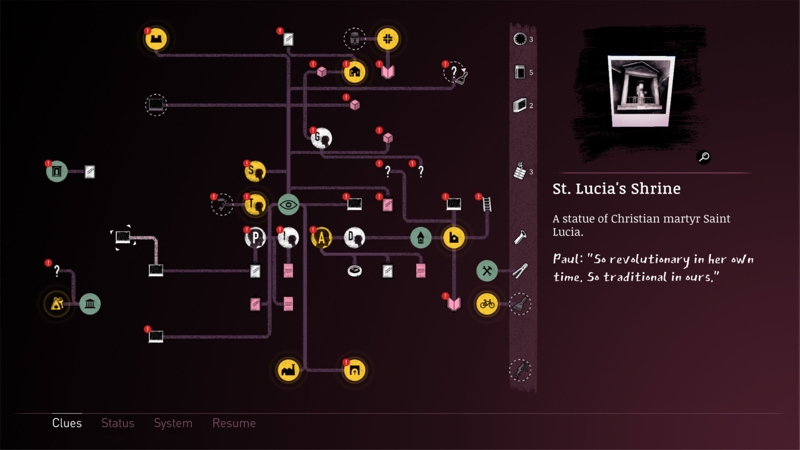A deadly secret hides behind the celebration of Saturnalia. Can you solve the mystery before it consumes you?
Odd rituals have always been part of human life. Whether it’s for religion or a family tradition, we’ve done them. And in Saturnalia, a group of friends gets to be unwilling participants in an ancient one. But they don’t have to be. Will Anita, Paul, Sergio, and Claudia must work together in order to solve the mysteries that plague each of them.
Developed and published by Santa Ragione, Saturnalia tells the story of the small Italian town of Gravoi. Located on the island of Sardinia, the small place is home to a long-standing mystery. With the festival of St. Lucia upon them, it is time for the ritual of Saturnalia. Praying to the god of the sun is one thing, but the creature that stalks the cobblestone walkways seeks a sacrifice to complete the ritual. Will the monster’s plans come to fruition? Or will the group be able to save themselves and each other from certain death?
Saturnalia had a wonderfully woven story. Despite playing four separate characters simultaneously, the developers did a fine job of tying everyone’s background and stories together. Each individual had a reason for needing or wanting to leave the town of Gravoi. While the characters themselves are controlled by the player themselves, certain dialogue options would only appear with specific pairs. It was a good way to show important certain characters were to each other, and in what way they could help each other, if at all.

The gameplay was relatively simple and easy to get the hang of. When it comes to horror, simple controls often feel the best. And the developers did a wonderful job of it. Moving around simply required both analog sticks, the right to move the camera and the left to help the characters navigate the environment. Additionally, one could run using the R trigger. When the game first starts, it’s hard to figure out what one could possibly need to run from. But, shortly after visiting the church atop the hill, it becomes quite clear a creature stalks the streets during the festival of St. Lucia.
Aside from moving the camera and characters, one also had to light matches every so often using LB. This was useful as there were bonfires scattered throughout the village of Gravoi. These helped with navigating back through the streets once certain items or pieces of information had been acquired. But it’s a bit of a pain to go and make sure they’re all lit.
Anita, Paul, Sergio, and Claudia all had their own special “abilities,” if they could be called that. Anita, when it was time to play her part, could navigate through the town with little problem. Her mind itself acted as its own map. And when one would stand still, the woman was able to commit to memory which direction a specific location was in. Claudia, as a young lady, was able to squeeze through some areas that had seemingly bent bars, allowing only someone her size to slip through. It was hard not to chuckle when escaping from Claudia’s father or the monster simply because they were too large to pass through a fence.

Paul, as a photojournalist, was able to document things from everyday newspaper clippings, to the strange marking signifying Saturnalia. Sergio, on the other hand, had what I felt was probably the best ability out of anyone. In addition to his satellite phone, the man had an insane amount of stamina. This, personally, was the best for a player with a good memory. If two related clues were at opposite ends of Gravoi, Sergio could quickly close the gap before the monster had a chance to catch up. But, were his stamina to run out, he’d end up the first person placed on the sacrificial altar at the center of town. And with the sacrifice would come the completion of the ritual of Saturnalia.
For the mystery-solving part of the game, the clues were placed on a chart alongside the Mission/Objective list. Conveniently, all related clues snaked around the chart together. If one were to get stuck at any point, the clue board could be referenced. Luckily for me, getting caught and having all my characters killed wasn’t truly the end for me.
If the player had the misfortune of getting everyone caught, I’d have to start all over again from the Villa, but I didn’t have to start at the beginning of the game. Gravoi would be reshuffled and the start point would be the Villa. I’d have all my characters, all gathered clues, and any items considered ‘key’ to the story. Most items in Saturnalia, like the bolt cutters, wrench, and soldering iron would go back to their respective locations. While it wouldn’t be personally recommended, one could go back to the default map layout by starting an entirely new game. But where’s the fun in that?

If I wanted to survive an encounter with the monster during Saturnalia, some weird stuff had to be done. The creature could not be looked in the eyes. If such a mistake were to occur, the character had to run before they became an unwilling sacrifice. Once the character was a safe distance away and out of sight, a hiding place needed to be found. Dumpsters or wardrobes could be used as covers. And, if neither could be found, the character had to crouch and avoid laying eyes directly on the creature. Once the ‘monster music’ stopped playing, it was then safe to continue exploring.
The artwork for Saturnalia was pretty amazing. Combined with a bit of what’s known as cel-shading, each character was drawn as if they were living sketches. While it can certainly be said to be amazing, it’s not recommended for those whose eyes are easily strained by odd visuals.
Sounds of the game delivered a perfect scare factor. There was never anything wrong with making a small bit of noise. But if one mistakenly set off an alarm or decided to swipe a few coins from a vending machine, the monster would be drawn directly to the source of the noise. After such a blunder, swift action had to be taken before getting snatched up. The intro music was fantastic as was the track that played after first getting taken by the creature.

All things considered, Saturnalia is a decent game. The clue board is something that many mystery games lack, giving this title an edge over others. And not having to run back and forth to re-acquire key items or clues is wonderful. Having a good memory will help with the gameplay, as usable items get shuffled back to their points of origin. If you’re down for a mystery title that is relatively short at six total hours of game time, this might be a great title for you.
Saturnalia is available on PlayStation 4, PlayStation 5, Nintendo Switch, and Xbox One for $19.99 USD.
For more on the latest in gaming, drop in for some gaming news. And if you’ve got some more time, check out some game reviews and check out our thoughts on the latest blockbuster title.















